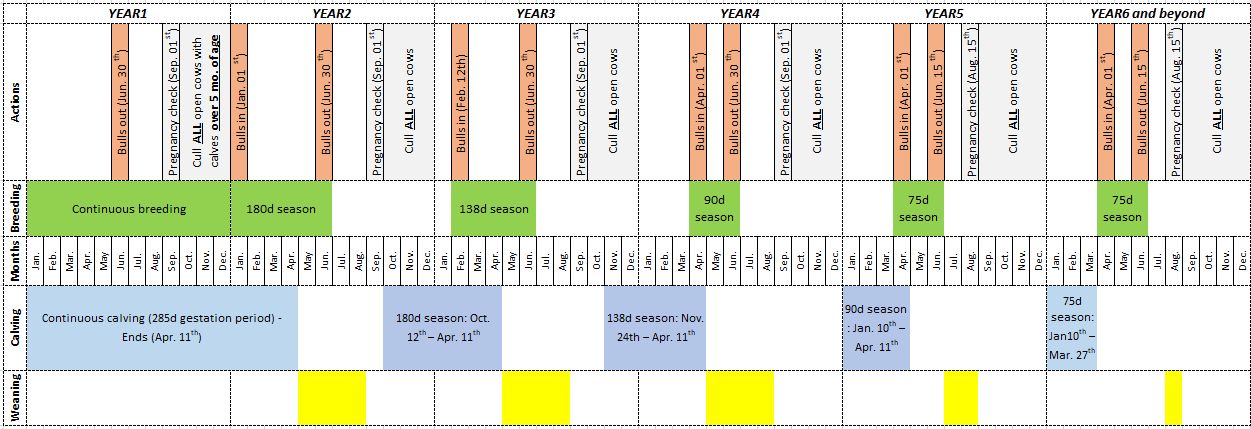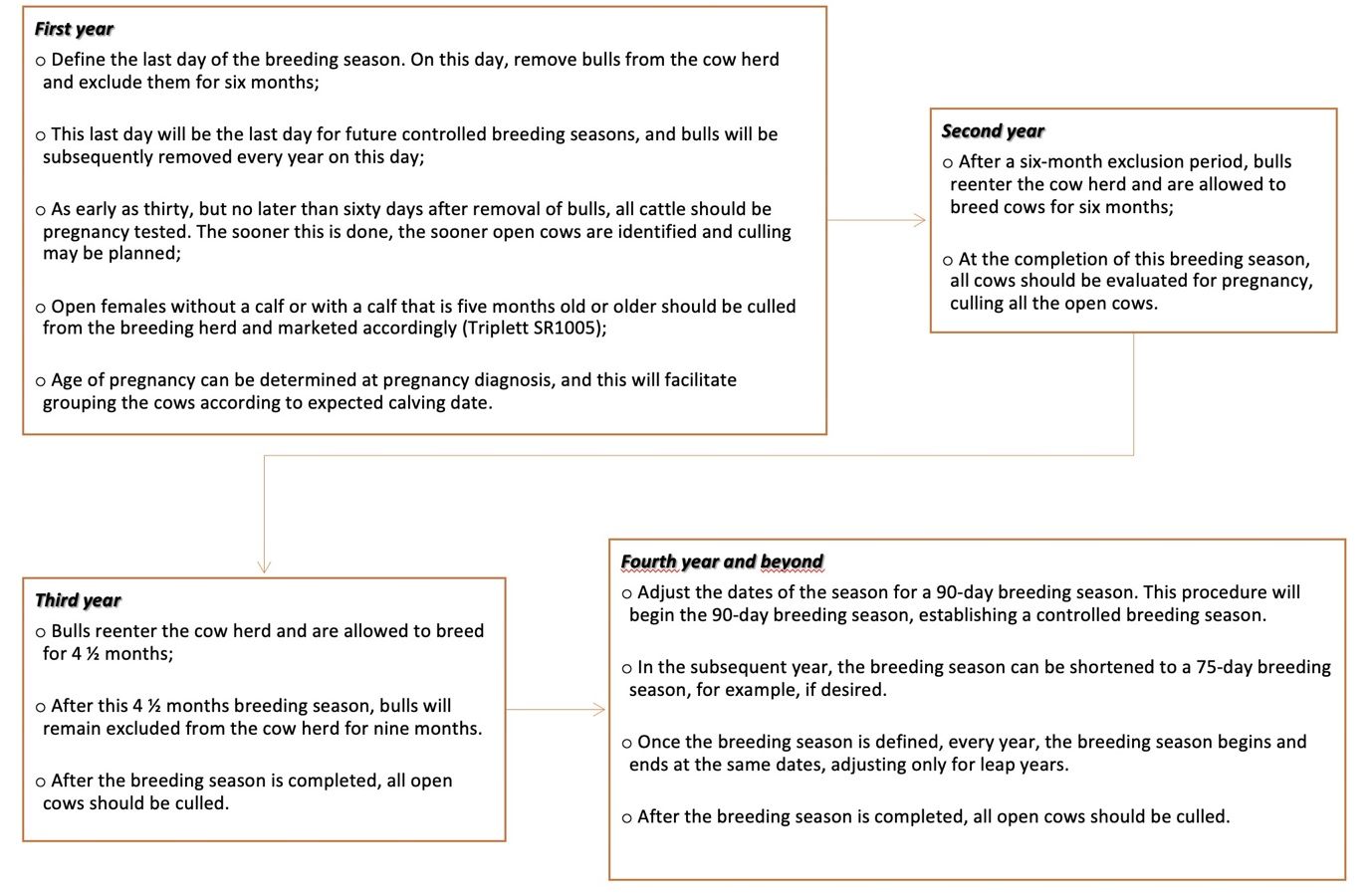Introduction
A controlled breeding season in beef cattle systems results from the implementation of specific, predetermined strategies on when to begin and end a breeding season. The length of a controlled breeding season varies depending on factors such as the marketing objective, size of the operation, and personal preference. Some controlled breeding seasons last only a few weeks, whereas others last several months. Although controlled breeding seasons have been recommended for a long time, approximately 69.5% of cow-calf operations, which account for 55.6% of cows in the eastern United States, continue to breed using a year-round breeding season (USDA 2020). Implementing a controlled breeding season to manage the length of the calving season is a cost-effective management practice that beef cattle producers can adopt (Troxel 2011). The objective of this report is to provide guidance to producers on practical aspects for moving from a system with no defined breeding season to a system with a defined season. This report is intended to be used by county Extension faculty who are educating producers on reproductive management for cow-calf operations, and by producers who are interested in taking steps to increase the reproductive efficiency of their herd.
Well-recognized advantages of establishing a controlled breeding season include the following (adapted from Triplett SR1005).
- Nutrition can be adjusted according to physiological status.
- Cows can be closely observed for calving difficulty.
- Calf crop will be more uniform in weight and age for marketing.
- Application of management and labor can be concentrated.
- Identification of reproductively unsound cows is facilitated.
Additional considerations are listed below.
- Herd health programs, especially for calves and virgin heifers, are easier to implement.
- Execution of reproductive technologies such as pre-breeding evaluation of females, estrus synchronization, artificial insemination, and pregnancy diagnostics are very efficient under a defined breeding season.
- Evaluation of offspring performance for selection purposes within the herd is facilitated due to the simultaneous management of animals.
- There is increased efficiency of resource use, including the choice of the best timing for calving, best timing for marketing calves and culling cows, and quicker identification and removal of unfit animals.
Converting to a Controlled Breeding Season
Beef cattle producers who use year-round breeding and would like to convert to a 90-day or 75-day controlled breeding season can do so in a four- to five-year program. The program is centered on defining a final day for breeding. Based on this final day, the beginning of the breeding season is progressively adjusted to a 90-day period or shorter (e.g., a 75-day breeding season). A yearly pregnancy diagnostic is used to select the cows to maintain in the herd within the desired breeding period. When the bulls are pulled out, the pregnancy diagnostic can be performed as early as 30 days after the last day of breeding by transrectal ultrasonography. Alternatively, the pregnancy diagnostic may be performed by transrectal palpation 60 days after the last day of breeding, but not later than that. The non-pregnant females should be culled. Based on the pregnancy information, managers will be able to determine if a large number of cows would need to be culled. As a parameter, data from the USDA (2020) report that the average calving rate among cows is 93.5%. Ideally, the herd pregnancy rate should be as close as possible to this standard. This facilitates the conversion to a controlled breeding season. However, when the pregnancy rate is low and many cows need to be culled, the producers can consider: leaving the cows with bulls and re-evaluating the breeding dates; splitting calving seasons; or culling the cows and replacing with heifers in the subsequent year, depending on the numbers of cows to be culled. The split calving seasons, nevertheless, involve dividing one herd into two, which results in two breeding seasons and two calving seasons. One advantage of this strategy is the reduction of the number of bulls needed during the breeding season because the cow herd is split into two groups. Another important advantage of having a defined breeding season pertains to nutrition. The dietary needs of cows vary based on stage of gestation. For example, cows in early lactation shortly after calving have much higher protein requirements than dry cows in the middle third of gestation. If cows are calving throughout the year, it is difficult to match the nutritional needs of all cows housed as one group. A defined breeding season in which all cows are in similar stages of gestation also makes practices such as vaccination more convenient.
Successful incorporation of a split calving season method of controlled breeding requires additional pastures, management, and time. Producers limited in these resources should consider an alternative approach. According to the USDA’s 2020 report, only a minor proportion of beef cattle enterprises uses split calving seasons. Table 1 summarizes the traditional breeding and respective calving and weaning dates in the US.
Table 1. Traditional breeding, calving, and weaning months in the United States beef cattle industry (Adapted from Griffith W149).
Implementing a Controlled Breeding Season
To successfully complete the transition from year-round breeding to a controlled breeding season, a strong bullpen must be constructed to hold bulls when they are removed from the herd. Bulls can escape from inadequate facilities and reenter the cow herd. If producers do not want to build additional pens or have limited acreage, there are other ways to separate bulls from the herd. Alternatives include maintaining bulls at a remote pasture, leasing pasture space specifically for bulls, or leasing bulls. Bulls must undergo a complete breeding soundness exam prior to the start of the breeding period to ensure that healthy, fertile, and functional bulls are used. The producers can also consider the implementation of estrus synchronization programs (https://beefrepro.org/wp-content/uploads/2022/01/2022-Cow-and-Heifer-Protocols-for-Sire-Directories.pdf) in a controlled breeding season. One advantage of such programs is that animals are massively bred during a 3-day period, rather than during a 21-day period, when animals are allowed to come in estrus spontaneously. This helps to shorten the calving season. A shorter calving season results in calves that are more uniform in age at weaning. Additionally, synchronization will stimulate cyclicity in cows that are still under postpartum anestrus, and hasten breeding. Synchronization should be designed so that cows are ready to breed by natural service or AI at the first day of the breeding season. Eligible cows are the ones with calves that are 45 days old or older. Every year, cows with calves 45 days old or older can be synchronized and start the breeding season as a group. When using artificial insemination, we recommend monitoring cows and heifers for signs of estrus, and breeding the animals based on estrus. Animals inseminated in estrus presented greater pregnancy rates than the non-estrus animals submitted to timed artificial insemination (65% vs. 31%; n=7,105 females; data compiled from the multibreed herd of the University of Florida). Advantages of using artificial insemination include reducing or eliminating the need for bulls on the operation, and having access to semen from sires of superior genetic merit (straws of semen are much less expensive than purchasing a bull of superior genetic merit). In addition, genetic improvements in the herd can be achieved more rapidly by using artificial insemination rather than natural breeding.
Producers must determine a timeline of events that begins with their intended market endpoint, when they wish to sell calves. Identifying a market endpoint is the first step in determining when calves should be weaned. The determined market endpoint will provide the direction needed to produce the type of calf acceptable to segments of the beef industry (i.e., in terms of age, type, weight, etc.). Establishing when calves will be sold will help to determine what management practices should be performed and when they should be completed. Multiple factors, such as forage availability, temperature, market trends, and labor, should be considered when determining the market endpoint.
A simple-to-follow timeline presented in Figure 1 can be used to convert from a year-round breeding program using a three- to four-year approach.The model presented in Figure 1 is compatible with a breeding season that defines a winter calving season, but the beef operations can use the same principles to establish alternative calving seasons, such as those depicted in Table 1. Using this method of conversion, cows are gradually culled over multiple years, thereby decreasing the number of cows culled in a single year. A summary of procedures for the conversion to a controlled breeding season is presented in Figure 2.

Credit: Binelli Lab

Credit: Binelli Lab
Summary
Controlled breeding offers cow-calf producers many benefits related to management and profits. Facilitating herd health activities, culling reproductively unsound cattle, and marketing a uniform calf crop all have positive impacts on production revenue. Early detection of open cows decreases costs of maintaining unproductive cows. The use of a synchronization protocol stimulates early cyclicity and early breeding, which contributes to a faster transition to a short breeding season. Finally, implementing a controlled breeding season is the first significant step towards the technification of the reproductive management of the ranch. Successful implementation of this technology provides the basis for subsequent strategies that will increase efficiency and revenue from the cow-calf operation. If you have questions related to controlled breeding or ways to successfully complete this process, contact your county Extension agent, state beef Extension specialist, or large animal veterinarian.
References
Griffith, A. P., C. N. Boyer, G. W. Henry, J. A. Larson, S. Aaron Smith, and K. E. Lewis. n.d. “Fall Versus Spring Calving: Considerations and Profitability Comparison.” W419. W419.pdf (tennessee.edu).
Triplett, C. M. n.d. A Controlled, Seasonal Cattle Breeding Program. Southern Regional Beef Cow-Calf Handbook SR1005.
Troxel, T. R. 2011. “Real-Life Implementation of Controlled Breeding Season.” In 2011 Florida Beef Cattle Short Course. 47–52. Gainesville: University of Florida Institute of Food and Agricultural Sciences.
USDA. 2020. “Beef 2017: Beef Cow-Calf Management Practices in the United States, 2017.” USDA-APHIS-VS.